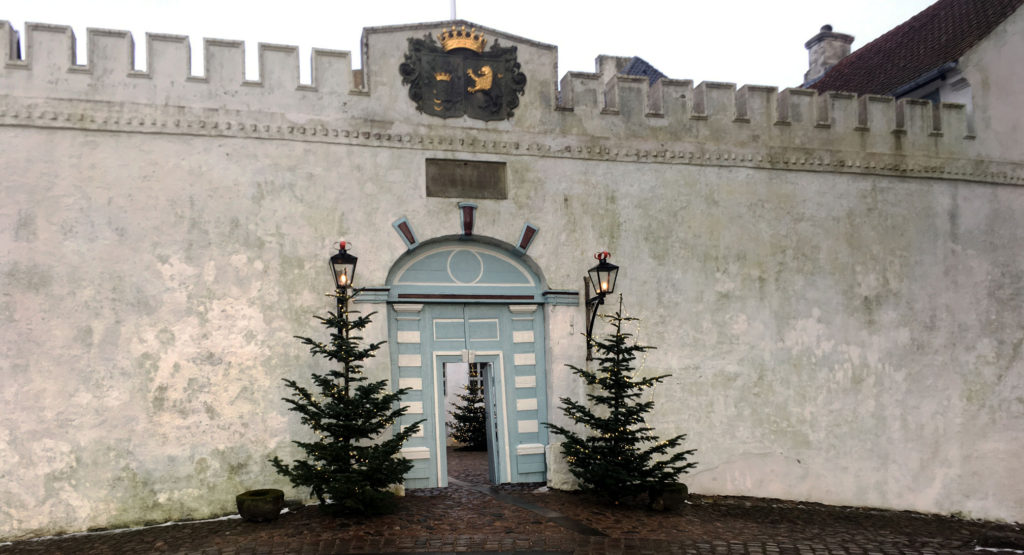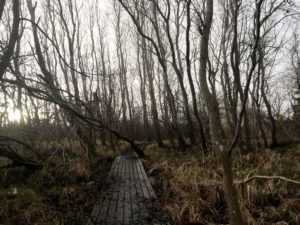I was incredibly lucky to spend Christmas in Denmark, the smallest Scandy country. Denmark is made up of a peninsula, Jutland, attached to Germany, and 443 islands, including the highly populated Zealand. (Copenhagen is on Zealand.) The tallest point of Denmark is 170.86 metres, on Jutland. The tallest point of Zealand is 122.9 m. This is before the elevation of buildings and burial mounds …
At the top North-West tip of Zealand is a UNESCO Geopark in an area called Odsherred. It’s about an hour and a half by train from Copenhagen.

An information sign near Asnæs shows Odsherred. The area I visited is up to the left, overlooking the curving bay.
Created in 2014, this Geopark exists to protect and enhance landscapes created by the Ice Age. In general, European Geoparks exist to protect items of interest, geological, historical or ecological and promote development of the surrounds, mainly by tourism. Many information signs are available throughout the park, especially on the many walks. Apparently when the thick layer of ice melted it left deposits of silt which provided fertile soils useful for farming.

Informative signage dotted through the Geopark reveals how ice formed the land and stories of the earliest settlers.
Much of the smooth landscape was reclaimed and drained from swamp. It’s now used to grow potatoes and carrots. You wouldn’t think a park would encourage farming, or in fact any industry. But whole towns and many lives are entwined with the Geopark.

Wintery farmland Odsherred showing the curves of the land. I just missed a little family of three deer trotting down the hill.
I’ve been listening to a podcast, ‘Scotland Outdoors’ from BBC Radio Scotland. On a recent episode, The National Parks Special, the discussion ranges between Scot and American park experiences, both of which have to include people. Scotland encourages development in their two National Parks; housing, communities and schools grow within park boundaries. In the USA, the rangers are aware that in order for parks to survive, indeed, nature to survive, people have to visit, have to experience looking up and looking out into distant vistas. There’s just no getting away from it. The Scots and Yank’s problems are the same. How to manage the amount of people using the park so that the treasured beauty and original purpose of the park is preserved for the next generations while still encouraging people to feel free enough to enjoy the place – without trashing it or doing something humanly possible.
Mike Reynolds from the National Park Service in the USA said, “People that visit National Parks come to generate babies in these parks and then they come to bury ashes of their relatives. The full spectrum of the human experience is often lived through these places, and they’re very personal and they bring solace to people and they bring inspiration … ”
Not so sure about the generation (especially in chilly winter!) but burial is certainly true of Odsherred. The Ridge path takes in several Bronze Age burial mounds.

A Celluloid Age burial mound houses the ashes of film-maker Ole Olsen and his wife, close to Bronze Age mounds.

Esterhøj Reunion Stone celebrates the peaceful agreement to decide Germany’s and Denmark’s borders. The citizens voted to decide which country they’d prefer to live in. There’s no doubt this stone is well and truly in Denmark. It stands on a Bronze Age burial mound at 89metres above sea level.
The inspiration part of Reynold’s comments hold true for Denmark too. Many artists have lived in Odsherred, trying to capture the light and curves of the landscape. Two artists, excited by the creation of the UNESCO Geopark, worked with the schools of the area to create a celebration of people in the landscape. Even though there wouldn’t have been too many humans in the vicinity in the Ice Age, the park is all about people now. Lots of them!
As well as geology, Bronze Age artifacts and medieval churches, holiday makers and visitors to Odsherred could take a look at Dragsholm Castle, the largest edifice in the area. Named after a stretch of water where Vikings would ‘drag’ their ships instead of getting caught up in dangerous northern waters, the Castle has been there in some form for over 800 years. The Baron of a century or so ago ordered nearby lands to be extensively drained and donated to the poor to see if they could scrape some subsistence living out of them. (Things have come a long way since then.) The castle has been used as a fort, a prison and now, a fancy restaurant. Apparently there are ghosts, including poor old 4th Earl of Bothwell, whose body was kept in the dungeon for seven years before they decided to bury him.

Dragsholm Slot really love their Christmas trees
I imagine the forests, now still and leafless, must be completely different in their summer green wear. Even so, the forests are effective shields to wind and can block outside views even while cold and brown.
The coast is never far away in Odsherred with incoming storms quickly blown away and replaced by weak wintery sun.

Looking back to dry land from Korevle, where a sand spit has evolved into a large barrier creating the beginnings of a lagoon
Even though Odsherred is an evocative place in winter, I would love to return in Summer, when the Viking museums and art galleries are open. And, although I did enjoy the enthusiastic fireworks of New Year celebrations, I suspect I might prefer the more restrained bonfires of the summer solstice! There will be more people in summer, enjoying the amenities of the Geopark while learning about Sun worship and protecting our environment. For if we don’t have parks to share information and space to play in nature, we won’t have nature. And that’s us. It’s personal, in the end.

















